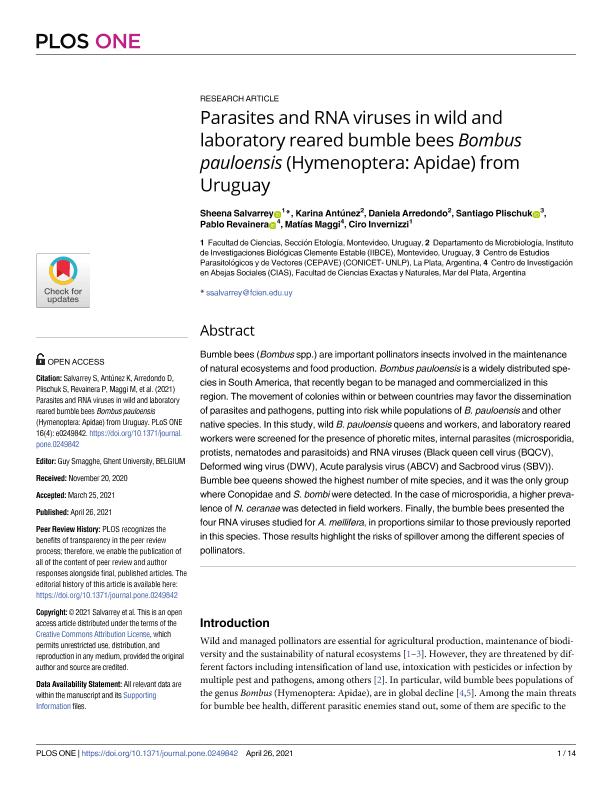Artículo
Parasites and RNA viruses in wild and laboratory reared bumble bees Bombus pauloensis (Hymenoptera: Apidae) from Uruguay
Salvarrey, Sheena; Antúnez, Karina; Arredondo, Daniela; Plischuk, Santiago ; Revainera, Pablo Damian
; Revainera, Pablo Damian ; Maggi, Matías Daniel
; Maggi, Matías Daniel ; Invernizzi, Ciro
; Invernizzi, Ciro
 ; Revainera, Pablo Damian
; Revainera, Pablo Damian ; Maggi, Matías Daniel
; Maggi, Matías Daniel ; Invernizzi, Ciro
; Invernizzi, Ciro
Fecha de publicación:
04/2021
Editorial:
Public Library of Science
Revista:
Plos One
ISSN:
1932-6203
Idioma:
Inglés
Tipo de recurso:
Artículo publicado
Clasificación temática:
Resumen
Bumble bees (Bombus spp.) are important pollinators insects involved in the maintenance of natural ecosystems and food production. Bombus pauloensis is a widely distributed species in South America, that recently began to be managed and commercialized in this region. The movement of colonies within or between countries may favor the dissemination of parasites and pathogens, putting into risk while populations of B. pauloensis and other native species. In this study, wild B. pauloensis queens and workers, and laboratory reared workers were screened for the presence of phoretic mites, internal parasites (microsporidia, protists, nematodes and parasitoids) and RNA viruses (Black queen cell virus (BQCV), Deformed wing virus (DWV), Acute paralysis virus (ABCV) and Sacbrood virus (SBV)). Bumble bee queens showed the highest number of mite species, and it was the only group where Conopidae and S. bombi were detected. In the case of microsporidia, a higher prevalence of N. ceranae was detected in field workers. Finally, the bumble bees presented the four RNA viruses studied for A. mellifera, in proportions similar to those previously reported in this species. Those results highlight the risks of spillover among the different species of pollinators.
Palabras clave:
BOMBUS SPP.
,
MITES
,
MICROSPORIDIA
,
VIRUS
,
SPILLOVER
Archivos asociados
Licencia
Identificadores
Colecciones
Articulos(CEPAVE)
Articulos de CENTRO DE EST.PARASITOL.Y DE VECTORES (I)
Articulos de CENTRO DE EST.PARASITOL.Y DE VECTORES (I)
Citación
Salvarrey, Sheena; Antúnez, Karina; Arredondo, Daniela; Plischuk, Santiago; Revainera, Pablo Damian; et al.; Parasites and RNA viruses in wild and laboratory reared bumble bees Bombus pauloensis (Hymenoptera: Apidae) from Uruguay; Public Library of Science; Plos One; 16; 4; 4-2021; 1-14
Compartir
Altmétricas



